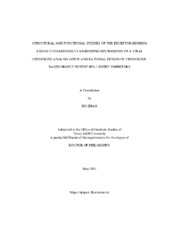| dc.description.abstract | Chemokines are small immune system proteins mediating leukocyte migration and activation, and are important in many aspects of health and diseases. Some chemokines also have the ability to block HIV-1 infection by binding to the HIV-1 co-receptors CCR5 (CC chemokine receptor 5) and CXCR4 (CXC chemokine receptor 4). The first part of this work is to determine the mechanism of action of a human herpesvirus-8 encoded viral chemokine analog vMIP-II (viral macrophage inflammatory protein-II) by characterizing its interactions with endothelial surface glycosaminoglycans (GAGs) and cell surface receptors. Nuclear magnetic resonance (NMR), mutagenesis and molecular-docking were conducted and results show that vMIP-II tightly binds glycosaminoglycans using residues distributed along one face of the protein, such as R18, R46 and R48, and that there is a shift in the GAG binding site between the monomer and dimer form of vMIP-II where the N-terminus is involved in GAG binding for the dimer. This study, for the first time, provides a model that explains the mechanism of how quaternary structure affects chemokine-GAG binding. Mutagenesis and competition binding assays were conducted to study the receptor-binding mechanism of vMIP-II. Preliminary results suggest that vMIP-II uses the same positively charged binding surface comprising R18, K45, R46 and R48 to interact with the negatively charged N-termini of CCR5 and CXCR4. NMR studies on how vMIP-II interacts with N-terminal peptides of CCR5 and CXCR4 is on-going.
The second part of this work was to rationally design HIV-1 entry inhibitors based on our knowledge of the mechanisms of chemokine-receptor binding and HIV-1 cell entry. We successfully designed two chimeric HIV entry inhibitors composed of CCR5-targeting RANTES variants (5P12-RANTES and 5P14-RANTES) linked to a gp41 targeting C-peptide, C37. In in vitro assays, chimeric inhibitors 5P12-linker-C37 and 5P14-linker-C37 showed the highest anti-viral potency yet published with IC50 values as low as 0.001 nM against certain virus strains. On human peripheral blood mononuclear cells, the chimeric inhibitors also exhibited very strong inhibition against R5-tropic and X4-tropic viruses, with IC50 values as low as 0.015 nM and 0.44 nM, respectively. A clear delivery mechanism was observed and characterized. These fully recombinant inhibitors can be easily produced at low cost and are excellent candidates for HIV microbicides. | en |


